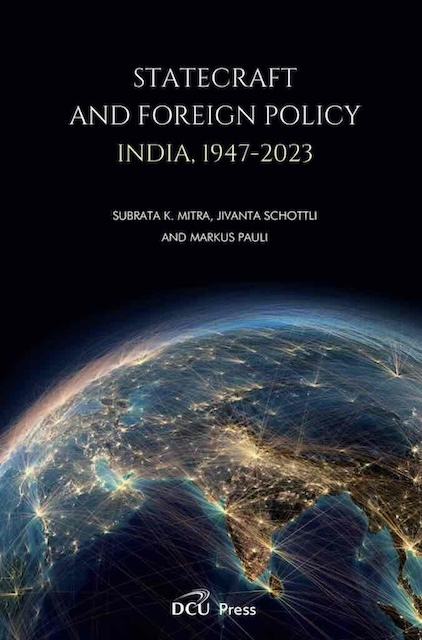Statecraft and Foreign Policy- India, 1947–2023

Review by Sonakshi Garg (July 17, 2024): The term ‘Foreign Policy’, which gained prominence in the 19th century, became essential in the 20th century, and now, in the 21st century, has become a fundamental aspect of governance and public discourse. Hans J. Morgenthau, in his seminal work "Politics Among Nations: The Struggle for Power and Peace" (1948), defines foreign policy as the system of activities evolved by communities to change the behaviour of other states and adjust their activities to the international environment. This concept is intricately linked to solidifying nation-states as the primary organising principle of human allegiance and civilisation. Consequently, the political history of nation-states provides a crucial framework for understanding and analysing a state's foreign policy.
In the era of globalisation, political analysts and actors have renewed their vigour and passion for studying the relationships between states. Isolationism is now an unthinkable phenomenon, and the prosperity of nations is increasingly dependent on interconnectivity. Governments must strategically choose allies and adversaries, aligning with foreign entities that support their survival and development. Nations, much like individuals, develop distinct personas based on their history, political structure, and shared experiences. These personas influence alliances and enmities, often grounded in common ideological, economic, and sociological principles.
India, as it embraces the new age with aspirations of regional leadership and global influence, places significant emphasis on its foreign policy. This arena has become a stage for showcasing India’s prowess and leadership. Theorists have emerged, exploring optimal foreign policies based on past mistakes, historical achievements, collective consciousness, and future ambitions. Each theoretical framework offers its own merits and drawbacks.
Statecraft and Foreign Policy, India 1947-2023 (DCU PRESS, Dublin, 2023), authored by Subrata K. Mitra, Jivanta Schottli, and Markus Pauli, provides a comprehensive examination of India's foreign policy from its inception in 1947 to the present.
The book highlights major milestones, leaders, and events that have shaped India's statecraft. A particularly noteworthy feature is the "toolbox," an intellectual index designed to aid in dissecting foreign policy choices. The authors challenge dominant theories such as neoliberalism and constructivism, advocating for greater scrutiny of the roles of individual decision-makers and the contextual backgrounds that influence their decisions.
The book is structured into three main parts, each addressing distinct phases and aspects of India's foreign policy. The first part maps the evolution of India's foreign policy, considering the impacts of national leaders, domestic and international events, and regional dynamics. It examines the roles of figures like Jawaharlal Nehru, Indira Gandhi, and Narendra Modi and explores the complex relationships with neighbouring countries such as Pakistan and China. The authors also discuss how collective consciousness and psychological narratives have influenced India's decisions regarding its neighbours. Intriguingly, the book notes that early Indian citizens showed little interest in international policies, with parliamentary dialogue on external matters rare. Despite this, international politics profoundly impacted nation-building efforts, as evidenced by wars with neighbours, colonial experiences, and ideologies like socialism and nationalism.
The second part of the book delves into India's foreign policy in the post-Cold War era, highlighting the need to reassess old alliances and adversaries. It examines India's nuclearisation plans, its evolving relationship with the United States, and its renewed diplomatic engagements with states in West Asia and South Asia. Lastly, the book culminates by bringing India to its present diplomatic hurdles or opportunities by discussing pressing issues such as globalisation and climate change and India's growing interactions with international organisations like ASEAN and BRICS.
The book does not shy away from criticising India's foreign policy, many of which originate from foreign theorists who argue that India’s policies are often inconsistent and lack long-term planning. The authors provide ample data, theories, and case studies, allowing readers to either accept or challenge these criticisms. This critical engagement fosters a deeper understanding of India's foreign policy and encourages informed citizenship.
One of the book's strengths is its thorough research and detailed analysis. Repeated references to singular events across different parts of the book help readers understand occurrences from multiple perspectives using the tools provided in the toolbox. For example, Indian nuclearisation is analysed regarding regional dynamics, domestic ideologies, and the formation and dissolution of international relationships.
In conclusion, this book is not just a chronicle of India's foreign policy but a guide to understanding India's history, psychology, leadership, and domestic structure. By offering a comprehensive yet concise exploration of India as a rising power, the book provides valuable insights into analysing and predicting state actions in the international domain, considering factors such as psychology, history, sociology, political structures, economics, international relationships, and aspirations.
This book is definitely an essential read for scholars, policymakers, and anyone interested in India's foreign policy and its implications for the global order.
[SONAKSHI GARG (Research Intern: June -July 2024) is pursuing her law degree at O.P. Jindal Global University, Sonipat, Haryana.]